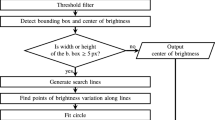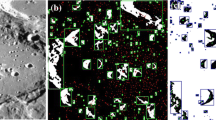Abstract
This paper describes the preliminary study results of developing a hypervelocity terminal intercept guidance system of a multiple kinetic-energy impactor vehicle (MKIV). The proposed MKIV system is intended to fragment or pulverize an asteroid of smaller than approximately 150 m in diameter that is detected with a mission lead time of shorter than 10 years, without using nuclear explosive devices. This paper focuses on the development of a new image processing algorithm based on Otsu’s method for the coordinated terminal intercept guidance and control of multiple kinetic-energy impactors employing visual and/or infrared sensors. A scaled polyhedron shape model of asteroid (216) Kleopatra is used as a fictional target asteroid. GPU-based simulation results demonstrate the feasibility of impacting a small irregular-shaped asteroid by using the proposed new image processing algorithm and a classical pulsed TPN (true proportional navigation) terminal guidance law.
Similar content being viewed by others
Change history
11 February 2022
A Correction to this paper has been published: https://doi.org/10.1007/s42064-022-0136-2
References
Wie, B. Hypervelocity nuclear interceptors for asteroid disruption. Acta Astronautica, 2013, 90(1): 146–155.
Pitz, A., Kaplinger, B., Vardaxis, G., Winkler, T., Wie, B. Conceptual design of a hypervelocity asteroid intercept vehicle (HAIV) and its flight validation mission. Acta Astronautica, 2014, 94(1): 42–56.
Barbee, B. W., Wie, B., Steiner, M., Getzandanner, K. Conceptual design of a flight validation mission for a hypervelocity asteroid intercept vehicle. Acta Astronautica, 2015, 106: 139–159.
Lyzhoft, J., Hawkins, M., Kaplinger, B., Wie, B. GPU-based optical navigation and terminal guidance simulation of a hypervelocity asteroid intercept vehicle (HAIV). In: Proceedings of AIAA Guidance, Navigation, and Control Conference, 2013.
Lyzhoft, J., Wie, B. A new terminal guidance sensor system for asteroid intercept or rendezvous missions. In: Proceedings of the 4th IAA Planetary Defense Conference, 2015, 13–17.
Lyzhoft, J., Basart, J., Wie, B. A new terminal guidance sensor system for asteroid intercept or rendezvous missions. Acta Astronautica, 2016, 119: 147–159.
National Near-Earth Object Preparedness Strategy and Action Plan. Interagency working group for detecting and mitigating the impact of earth-bound near-earth objects. National Science & Technology Council, 2018.
Mission to Comet Tempel 1: Deep impact. Jet Propulsion Laboratory, NASA, 2005. Available at https://doi.org/www.jpl.nasa.gov/missions/deep-impact/.
Mastrodemos, N., Kubitschek, D. G., Synnott, S. P. Autonomous navigation for the deep impact mission encounter with comet tempel 1. Space Science Reviews, 2005, 117(1–2): 95–121.
Strickland, B. R., Lianos, D. P. A midcourse multiple kill vehicle defence against submunitions. In: Proceedings of Defense and Space Programs Conference and Exhibit–Critical Defense and Space Programs for the Future, 1997.
Payton, G. Advanced concepts in missile defense. The George C. Marshall Institute, 2005, 14–20. Available at https://doi.org/www.forinpol.pl/missiledefenseprojecthercules.pdf.
Williams, D. S., Pflibsen, K. P., Crawford, T. M. Multiple kill vehicle (MKV) interceptor and method for intercepting exo and endo-atmospheric targets: U.S. Patent 7494089. 2009-02-24.
Leal, M. A., Baker, T. L., Pflibsen, K. P. Multiple kill vehicle (MKV) interceptor with autonomous kill vehicles: U.S. Patent 7494090. 2009-02-24.
Wie, B., Zimmerman, B., Premaratne, P., Lyzhoft, J., Vardaxis, G. A new non-nuclear MKIV (multiple kinetic-energy impactor vehicle) mission concept for dispersively pulverizing small asteroids. In: Proceedings of AAS/AIAA Astrodynamics Specialist Conference, 2015.
Wie, B., Zimmerman, B., Lyzhoft, J., Vardaxis, G. Planetary defense mission concepts for disrupting/pulverizing hazardous asteroids with short warning time. Astrodynamics, 2017, 1(1): 3–21.
Zimmerman, B., Wie, B. A GPU-accelerated computational tool for asteroid disruption modeling and simulation. In: Proceedings of AAS/AIAA Astrodynamics Specialist Conference, 2015.
Zimmerman, B. J., Wie, B. GPU-accelerated computational tool for studying the effectiveness of asteroid disruption techniques. Acta Astronautica, 2016, 127: 644–654.
Zimmerman, B. J., Wie, B. Graphics-processingunit- accelerated multiphase computational tool for asteroid fragmentation/pulverization simulation. AIAA Journal, 2017, 55(2): 599–609.
Box, G. E. P., Mervin, M. E. A note on the generation of random normal deviates. The Annals of Mathematical Statistics, 1958, 29(2): 610–611.
Otsu, N. A threshold selection method from gray-level histograms. IEEE Transactions on Systems, Man, and Cybernetics, 1979, 9(1): 62–66.
Huang, D. Y., Lin, T. W., Hu, W. C. Automatic multilevel thresholding based on two-stage Otsu’s method with cluster determination by valley estimation. International Journal of Innovative Computing, Information and Control, 2011, 7(10): 5631–5644.
Huang, M. X., Yu, W. J., Zhu, D. H. An improved image segmentation algorithm based on the Otsu method. In: Proceedings of the 13th ACIS International Conference on Software Engineering, Artificial Intelligence, Networking and Parallel/Distributed Computing, 2012.
Kegelmeyer, L. M., Fong, P. W., Glenn, S. M., Liebman, J. A. Local area signal-to-noise ratio (LASNR) algorithm for image segmentation. In: Proceedings of SPIE 6696, Applications of Digital Image Processing XXX, 2007.
Gil-Fernández, J., Panzeca, R., Corral, C. Impacting small near earth objects. Advances in Space Research, 2008, 42(8): 1352–1363.
Hawkins, M., Pitz, A., Wie, B., Gil-Fernández, J. Terminal-phase guidance and control analysis of asteroid interceptors. In: Proceedings of AIAA Guidance, Navigation, and Control Conference, 2010.
Hawkins, M., Guo, Y. N., Wie, B. Spacecraft guidance algorithms for asteroid intercept and rendezvous missions. International Journal of Aeronautical and Space Sciences, 2012, 13(2): 154–169.
Wie, B. Space vehicle guidance, control, and astrodynamics. American Institute of Aeronautics & Astronautics, 2015, 431–435, 570–596.
Lim, L. F., McConnochie, T. H., Bell III, J. F., Hayward, T. L. Thermal infrared (8–13 µm) spectra of 29 asteroids: the Cornell mid-infrared asteroid spectroscopy (MIDAS) survey. Icarus, 2005, 173(2): 385–408.
Aydin, A. T. Orbit selection and EKV guidance for space-based ICBM intercept. M.S. Dissertation, Naval Postgraduate School, Monterey, CA, USA, 2005.
Pue, A. J., Hildebrand, R. J., Clemens, D. E., Gottlieb, J. R., Bielefeld, J. M., Miller, T. C. Missile concept optimization for ballistic missile defense. Johns Hopkins APL Technical Digest, 2014, 32(5): 774–786.
Yéboles, D. M. Analysis and optimization of trajectories for ballistic missiles interception. Ph.D. Dissertation, Universidad Polit˜Al’cnica de Madrid, Madrid, Spain, 2015.
Xie, J. W., Chen, W. C. Switching logic design for divert and attitude control system of exoatmospheric kill vehicle. In: Proceedings of 2017 IEEE International Conference on Cybernetics and Intelligent Systems (CIS) and IEEE Conference on Robotics, Automation and Mechatronics, 2017, DOI: 10.1109/ICCIS.2017.8274773.
Li, S., Cui, P. Y., Cui, H. T. Vision-aided inertial navigation for pinpoint planetary landing. Aerospace Science and Technology, 2007, 11(6): 499–506.
Rizon, M., Yazid, H., Saad, P., Shaka, A. Y. M., Saad, A. R., Mamat, M. R., Yaacob, S., Desa, H., Karthigayan, M. Object detection using geometric invariant moment. American Journal of Applied Sciences, 2006, 3(6): 1876–1878.
Li, S., Lu, R. K., Zhang, L., Peng, Y. M. Image processing algorithms for deep-space autonomous optical navigation. The Journal of Navigation, 2013, 66(4): 605–623.
Quadrelli, M. B., Wood, L. J., Riedel, J. E., McHenry, M. C., Aung, M., Cangahuala, L. A., Volpe, R. A., Beauchamp, P. M., Cutts, J. A. Guidance, navigation, and control technology assessment for future planetary science missions. Journal of Guidance, Control, and Dynamics, 2015, 38(7): 1165–1186.
Christian, J. A. Optical navigation using planet’s centroid and apparent diameter in image. Journal of Guidance, Control, and Dynamics, 2015, 38(2): 192–204.
Mortari, D., D’Souza, C. N., Zanetti, R. Image processing of illuminated ellipsoid. Journal of Spacecraft and Rockets, 2016, 53(3): 448–456.
Du, S. L., Wang, M., Chen, X., Fang, S. H., Su, H. B. A high-accuracy extraction algorithm of planet centroid image in deep-space autonomous optical navigation. Journal of Navigation, 2016, 69(4): 828–844.
Wang, S., Cui, P. Y., Gao, A., Yu, Z. S., Cao, M. L. Absolute navigation for Mars final approach using relative measurements of X-ray pulsars and Mars orbiter. Acta Astronautica, 2017, 138: 68–78.
Author information
Authors and Affiliations
Corresponding author
Additional information
Bong Wie is Professor of Aerospace Engineering at Iowa State University. He was the founding director of the Asteroid Deflection Research Center established in 2008 at Iowa State University. In 2006, the AIAA (American Institute of Aeronautics and Astronautics) presented Professor Wie with the Mechanics and Control of Flight Award for his innovative research on advanced control of complex spacecraft such as agile imaging satellites, solar sails, and large space structures. He is the author of two AIAA textbooks “Space Vehicle Dynamics and Control”and“Space Vehicle Guidance, Control, and Astrodynamics”. He has published more than 200 technical papers including 75 journal articles, and he holds three U.S. patents on CMG singularity-avoidance steering logic. He was the PI of NASA’s NIAC (NASA Innovative Advanced Concepts) Phase 1 and 2 studies in 2011–2014 for developing planetary defense mission concepts.
Joshua Lyzhoft received his B.S. and Ph.D. degrees in aerospace engineering at Iowa State University, in 2012 and 2017, respectively. He became a Pathways Intern at NASA’s Goddard Space Flight Center in Greenbelt, Maryland in 2016. He received several awards: the best student paper award at the 2015 Planetary Defense Conference for his work in hypervelocity asteroid intercept, the Alexander Lippisch Scholarship, and an Iowa State University Research Excellence Award. Since 2017, he continued his work at NASA as a civil servant. His current research effort focuses on visual/infrared sensor modeling and simulation for space applications, digital image processing, and asteroid intercept terminal guidance.
Rights and permissions
About this article
Cite this article
Lyzhoft, J., Wie, B. New image processing algorithm for terminal guidance of multiple kinetic-energy impactors for disrupting hazardous asteroids. Astrodyn 3, 45–59 (2019). https://doi.org/10.1007/s42064-018-0035-x
Received:
Accepted:
Published:
Issue Date:
DOI: https://doi.org/10.1007/s42064-018-0035-x




